How To Make Wounds In Photoshop

Bruise Brush Photoshop
Written by Steve Patterson.In this tutorial, we'll learn how to make Photoshop your default program for viewing and editing photos on a Windows PC.Even though Photoshop comes with a great file management and organizer program called Adobe Bridge, many people still use Windows itself to locate and open their images. The problem is, by default, Windows doesn't open our images in Photoshop.Instead, it prefers to open them in Windows Photo Viewer. Or it may be opening them in some other program you've installed. Since Photoshop is obviously our image editor of choice, let's learn how to easily configure Windows so our photos will automatically open in Photoshop every time.And get exclusive bonus content!First, navigate to a folder on your computer's hard drive that contains one or more of your photos. Here, I've opened a folder that's sitting on my desktop. Inside the folder are three photos that were saved as standard. How do I know they're JPEG files?
How To Make Wounds In Photoshop
A: Open a new document in Photoshop. In the dialog box that pops up, make the new document whatever size you want your overall document (flyer. Q:How to Make Rounded Edges in Photoshop. A: Open Photoshop. Select 'File,' and click 'New.' In the dialog box that opens, make the width, height and resolution settings whatever you ne.
I know because of the '.jpg' extension at the end of their file names. Go to Open with Choose default program.This opens the Open With dialog box where you can choose a new default program for opening your JPEG files. Listed at the top are the Recommended Programs, the ones that Windows considers to be your best choices based on what's currently installed on your computer.
Photoshop may or may not appear in the list. If it is, go ahead and click on it to select and highlight it (but don't close out of the dialog box just yet). In my case, Photoshop is not listed, and if you don't see it either, click on the small arrow icon to open the Other Programs section for more options.
- At this point you can expand the hole to fill the metal part. Simply select the black circle (layer 2) and use ctrl+e to merge the black and white circles together. Then you can use the move tool ('V') to change the size. Your bullet hole is coming together now, and will look something like this: Now add a shadow.
- One of the reasons Photoshop brushes are so useful is because of their limitless use. Most of the brush packs that are available for free fall into one of several major categories, such as floral brushes, grunge brushes, splatter brushes, and of course a few others. However, there are also a number of unique and unusual brush packs that you may not be aware of.

Copy the image to the clipboard by pressing 'CTRL' + 'A' and then 'CTRL' + 'C.' Open Fontographer.
Click on 'File' and select 'New Font.' Choose the letter you created and double-click on it.Paste the image to the Fontographer canvas by pressing 'CTRL' + 'V.' Resize the image so that it is the proper size in the square provided.
Stretch the image by holding the shift key and dragging the corners of the image.Create an outline of your letter by pressing 'O' on your keyboard. In your layer palette, click on 'Outline.' Press 'CTRL' + 'SHIFT' + 'T' to trace the image.Save the image. Don't risk losing your work.Adjust the tracing around the image to ensure that it's all around the letter. When using the autotracer, the image is not always completely traced.
Use the dots around the image to help outline the letter.Use the arrow tool and press 'CTRL' + '8' to create a curved point instead of sharp edges, if desired.Adjust the lines sticking out of the point. Press 'CTRL' + 'SHIFT' + 'U' to place curve points. Move the points around for a more shapely letter.Press 'CTRL' + 'K' to preview the letter.Save the letter, close it and repeat the steps to create other letters.Open all the characters you have created, highlight them and press 'CTRL' + 'SHIFT' + 'K.'
This will auto-fix any problems with your font.Click 'Auto Kern' under 'Metrics' to kern your font.Under 'Element,' select 'Font Info' and then 'General.' Type in a name for your font and add a description.Set a vendor ID for your font under 'Element,' 'Font Info' and then 'OS/2 Data.' Set fsType embedding to $0000.Click on 'File,' 'Generate Font Files' and generate a Truetype font. Rename the file to a.ttf file and upload the font to your computer.